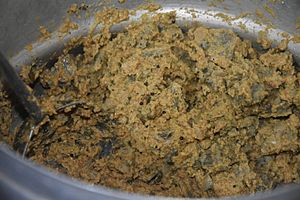Patrode facts for kids

Patrode
|
|
| Place of origin | India |
|---|---|
| Main ingredients | Gram flour, colocasia leaves |
| Variations | Patrode |
Patrode is a tasty vegetarian dish that comes from India. It's also known by different names in various parts of India and even in other countries! For example, it's called "Patra" in Gujarat, "Chembila Appam" in Kerala, and "Patrodo" in Maharashtra and Goa. In Himachal Pradesh, it's known as "Patrodu," and in Fiji, it's called "Saina." The word "Patra" in Sanskrit means leaf, and "vade" means dumpling, which tells you a lot about this dish!
Contents
What is Patrode Made Of?
Patrode is made from special leaves called colocasia leaves. These leaves are also known as taro or "arbi" in some places. The leaves are stuffed with a mix of gram flour or rice flour. To make it even more delicious, spices, tamarind (which gives a sour taste), and jaggery (a type of raw sugar) are added. Once stuffed, the leaves are usually steamed until they are perfectly cooked.
Health Benefits of Colocasia Leaves
Did you know that Patrode is not just yummy but also healthy? In 2021, the Union Ministry of AYUSH in India recognized Patrode as a traditional food recipe with health benefits.
Colocasia leaves are packed with good things for your body:
- They are rich in iron, which helps improve your blood's hemoglobin levels. Hemoglobin carries oxygen around your body, so it's super important!
- The leaves contain natural compounds like phenols and flavonoids. These can help reduce inflammation in your body, which is how your body reacts to injury or infection.
- They also have a lot of vitamin C and beta carotene. Vitamin C is great for your immune system, and beta carotene is good for your eyes and skin.
Important Tip for Cooking Patrode
When making Patrode, it's very important to cook the colocasia leaves properly. This is because raw colocasia leaves contain tiny crystals called calcium oxalate. If these crystals are not cooked away, they can make your mouth feel a bit scratchy, almost like "swallowing sand." In rare cases, they might even cause a mild upset stomach.
But don't worry! Most chefs know exactly how to prepare these leaves. By steaming or cooking them for the right amount of time, the crystals break down, and the leaves become perfectly safe and delicious to eat. Many other plants, like Swiss chard, also have these crystals, but they are completely fine to eat when prepared correctly.
See also
 In Spanish: Patrode para niños
In Spanish: Patrode para niños

